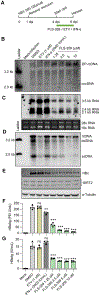An allosteric inhibitor of sirtuin 2 blocks hepatitis B virus covalently closed circular DNA establishment and its transcriptional activity
- PMID: 38641024
- PMCID: PMC12053749
- DOI: 10.1016/j.antiviral.2024.105888
An allosteric inhibitor of sirtuin 2 blocks hepatitis B virus covalently closed circular DNA establishment and its transcriptional activity
Abstract
296 million people worldwide are predisposed to developing severe end-stage liver diseases due to chronic hepatitis B virus (HBV) infection. HBV forms covalently closed circular DNA (cccDNA) molecules that persist as episomal DNA in the nucleus of infected hepatocytes and drive viral replication. Occasionally, the HBV genome becomes integrated into host chromosomal DNA, a process that is believed to significantly contribute to circulating HBsAg levels and HCC development. Neither cccDNA accumulation nor expression from integrated HBV DNA are directly targeted by current antiviral treatments. In this study, we investigated the antiviral properties of a newly described allosteric modulator, FLS-359, that targets sirtuin 2 (SIRT2), an NAD+-dependent deacylase. Our results demonstrate that SIRT2 modulation by FLS-359 and by other tool compounds inhibits cccDNA synthesis following de novo infection of primary human hepatocytes and HepG2 (C3A)-NTCP cells, and FLS-359 substantially reduces cccDNA recycling in HepAD38 cells. While pre-existing cccDNA is not eradicated by short-term treatment with FLS-359, its transcriptional activity is substantially impaired, likely through inhibition of viral promoter activities. Consistent with the inhibition of viral transcription, HBsAg production by HepG2.2.15 cells, which contain integrated HBV genomes, is also suppressed by FLS-359. Our study provides further insights on SIRT2 regulation of HBV infection and supports the development of potent SIRT2 inhibitors as HBV antivirals.
Keywords: Antiviral; Hepatitis B virus; SIRT2; Viral transcription; cccDNA synthesis.
Copyright © 2024 Elsevier B.V. All rights reserved.
Conflict of interest statement
Declaration of competing interest The authors declare the following financial interests/personal relationships which may be considered as potential competing interests.
Figures







Similar articles
-
Sirtuin 2 inhibitor AGK2 exerts antiviral effects by inducing epigenetic suppression of hepatitis B virus covalently closed circular DNA through recruitment of repressive histone lysine methyltransferases and reduction of cccDNA.Front Cell Infect Microbiol. 2025 Apr 9;15:1537929. doi: 10.3389/fcimb.2025.1537929. eCollection 2025. Front Cell Infect Microbiol. 2025. PMID: 40270769 Free PMC article.
-
Cellular DNA Topoisomerases Are Required for the Synthesis of Hepatitis B Virus Covalently Closed Circular DNA.J Virol. 2019 May 15;93(11):e02230-18. doi: 10.1128/JVI.02230-18. Print 2019 Jun 1. J Virol. 2019. PMID: 30867306 Free PMC article.
-
Hepatitis B virus genome recycling and de novo secondary infection events maintain stable cccDNA levels.J Hepatol. 2018 Dec;69(6):1231-1241. doi: 10.1016/j.jhep.2018.08.012. Epub 2018 Aug 22. J Hepatol. 2018. PMID: 30142426 Free PMC article.
-
Decoding the multifaceted interventions between human sirtuin 2 and dynamic hepatitis B viral proteins to confirm their roles in HBV replication.Front Cell Infect Microbiol. 2024 Jan 4;13:1234903. doi: 10.3389/fcimb.2023.1234903. eCollection 2023. Front Cell Infect Microbiol. 2024. PMID: 38239506 Free PMC article. Review.
-
Hepatitis B virus cccDNA: Formation, regulation and therapeutic potential.Antiviral Res. 2020 Aug;180:104824. doi: 10.1016/j.antiviral.2020.104824. Epub 2020 May 22. Antiviral Res. 2020. PMID: 32450266 Free PMC article. Review.
Cited by
-
Sirtuin 2 inhibitor AGK2 exerts antiviral effects by inducing epigenetic suppression of hepatitis B virus covalently closed circular DNA through recruitment of repressive histone lysine methyltransferases and reduction of cccDNA.Front Cell Infect Microbiol. 2025 Apr 9;15:1537929. doi: 10.3389/fcimb.2025.1537929. eCollection 2025. Front Cell Infect Microbiol. 2025. PMID: 40270769 Free PMC article.
-
Targeting HBV cccDNA Levels: Key to Achieving Complete Cure of Chronic Hepatitis B.Pathogens. 2024 Dec 13;13(12):1100. doi: 10.3390/pathogens13121100. Pathogens. 2024. PMID: 39770359 Free PMC article. Review.
-
Epigenetic drugs against human DNA viruses and retroviruses.Antiviral Res. 2025 Aug;240:106218. doi: 10.1016/j.antiviral.2025.106218. Epub 2025 Jun 23. Antiviral Res. 2025. PMID: 40562219 Review.
-
Drugs Targeting Sirtuin 2 Exhibit Broad-Spectrum Anti-Infective Activity.Pharmaceuticals (Basel). 2024 Sep 29;17(10):1298. doi: 10.3390/ph17101298. Pharmaceuticals (Basel). 2024. PMID: 39458938 Free PMC article. Review.
References
-
- Allweiss L, Giersch K, Pirosu A, Volz T, Muench RC, Beran RK, Urban S, Javanbakht H, Fletcher SP, Lutgehetmann M, Dandri M, 2022. Therapeutic shutdown of HBV transcripts promotes reappearance of the SMC5/6 complex and silencing of the viral genome in vivo. Gut 71, 372–381. 10.1136/gutjnl-2020-322571. - DOI - PMC - PubMed
-
- Alter H, Block T, Brown N, Brownstein A, Brosgart C, Chang KM, Chen PJ, Chisari FV, Cohen C, El-Serag H, Feld J, Gish R, Glenn J, Greten T, Guo H, Guo JT, Hoshida Y, Hu J, Kowdley KV, Li W, Liang J, Locarnini S, Lok AS, Mason W, McMahon B, Mehta A, Perrillo R, Revill P, Rice CM, Rinaudo J, Schinazi R, Seeger C, Shetty K, Tavis J, Zoulim F, 2018. A research agenda for curing chronic hepatitis B virus infection. Hepatology 67, 1127–1131. 10.1002/hep.29509. - DOI - PMC - PubMed
MeSH terms
Substances
Grants and funding
LinkOut - more resources
Full Text Sources

